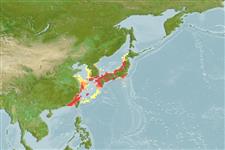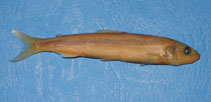Plecoglossus altivelis (Temminck & Schlegel, 1846)
Ayu sweetfish
Add your observation in Fish Watcher
| Native range | All suitable habitat | Point map | Year 2050 |

|
| This map was computer-generated and has not yet been reviewed. |
| Plecoglossus altivelis AquaMaps Data sources: GBIF OBIS |
Upload your photos and videos
Pictures | Stamps, coins, misc. | Google imagePlecoglossus altivelis
Picture by Islam, Md. S.
Pictures | Stamps, coins, misc. | Google imagePlecoglossus altivelis
Picture by Islam, Md. S.
Chinese Taipei (Taiwan) country information
Common names:
[No common name]
Occurrence: introduced
Salinity: freshwater
Abundance: | Ref:
Importance: minor commercial | Ref: FAO, 2000
Aquaculture: commercial | Ref: Liao, C.-I., H.-M. Su and E.Y. Chang, 2001
Regulations: | Ref:
Uses: no uses
Comments: Native stock extirpated after manmade damage to environment (Ref. 6300). Existing stocks introduced from Japan (Ref. 5193). Cultivated for local consumption and for export to Japan (Ref. 6300). First successful larviculture in Taiwan occurred in 1979 (Ref. 40297). Also Ref. 559.
National Checklist:
Country Information: https://www.cia.gov/library/publications/resources/the-world-factbook/geos/tw.html
National Fisheries Authority:
Occurrences: Occurrences Point map
Main Ref: Liao, I.-C. and H.-C. Lia, 1989
National Database: The Fish Database of Taiwan
Occurrence: introduced
Salinity: freshwater
Abundance: | Ref:
Importance: minor commercial | Ref: FAO, 2000
Aquaculture: commercial | Ref: Liao, C.-I., H.-M. Su and E.Y. Chang, 2001
Regulations: | Ref:
Uses: no uses
Comments: Native stock extirpated after manmade damage to environment (Ref. 6300). Existing stocks introduced from Japan (Ref. 5193). Cultivated for local consumption and for export to Japan (Ref. 6300). First successful larviculture in Taiwan occurred in 1979 (Ref. 40297). Also Ref. 559.
National Checklist:
Country Information: https://www.cia.gov/library/publications/resources/the-world-factbook/geos/tw.html
National Fisheries Authority:
Occurrences: Occurrences Point map
Main Ref: Liao, I.-C. and H.-C. Lia, 1989
National Database: The Fish Database of Taiwan
Common names from other countries
Classification / Names প্রচলিত নাম সমূহ | প্রতিনাম সমূহ | Catalog of Fishes(গণ , প্রজাতি ) | ITIS | CoL | WoRMS | Cloffa
> Osmeriformes (Freshwater smelts) > Plecoglossidae (Ayu fish)
Etymology: Plecoglossus: Greek, pleko, plekein = to fold + Greek, glossa = tongue (Ref. 45335).
More on authors: Temminck & Schlegel.
Etymology: Plecoglossus: Greek, pleko, plekein = to fold + Greek, glossa = tongue (Ref. 45335).
More on authors: Temminck & Schlegel.
Issue
All subspecies of Plecoglossus altivelis (Temminck & Schlegel, 1846) are synonymised under the species in Eschmeyer (CofF ver. Jul. 2010: Ref. 84883). Please send references, or more studies are needed.
Environment: milieu / climate zone / depth range / distribution range বাস্তুসংস্থান
সামুদ্রিক; স্বাদু পানি; ঈষৎ লোনা তলদেশ বিহারী; এ্যামফিড্রমাস (Ref. 51243); গভীরতার পরিসীমা 10 - ? m. Subtropical; 44°N - 23°N
বিতরণ দেশ সমূহ | এফ এ ও এলাকাসমূহ | বাস্তুতন্ত্র | দৃষ্টিগোচর | Point map | প্রচলন | Faunafri
Northwest Pacific: western Hokkaido in Japan southward to the Korean Peninsula, Taiwan and China.
Length at first maturity / আকৃতি / ওজন / Age
Maturity: Lm 27.5, range 30 - 40 cm
Max length : 70.0 cm TL পুরুষ/ লিঙ্গ অনিধর্ারিত ; (Ref. 12218); common length : 15.0 cm SL পুরুষ/ লিঙ্গ অনিধর্ারিত ; (Ref. 35840); সর্বোচ্চ উলি্ল্লখিত বয়স : 3.00 বৎসর (Ref. 12218)
Max length : 70.0 cm TL পুরুষ/ লিঙ্গ অনিধর্ারিত ; (Ref. 12218); common length : 15.0 cm SL পুরুষ/ লিঙ্গ অনিধর্ারিত ; (Ref. 35840); সর্বোচ্চ উলি্ল্লখিত বয়স : 3.00 বৎসর (Ref. 12218)
Short description সনাক্তকারী নির্দেশক | বহিঃ অঙ্গ সংস্থান | মরফোমেট্রিক্স
পৃষ্ঠীয় কাঁটা (মোট ) : 0; পৃষ্ঠীয় নরম পাখনা দন্ড (মোট ) : 10 - 11; পায়ূর নরম পাখনা্তুন্ড: 14 - 15; কশেরুকা : 60 - 63. Pyloric caeca 350-400.
Typical amphidromous fish; appears in near shore from late autumn to spring (Ref. 11230). Found in lakes and rivers, preferring clean river water and can be found the entire river long, from the head to the mouth (Ref. 12218). Ascends the river during March when the temperature is around 10°C (Ref. 12218). Adults spawn in the spring, in the lower reaches of rivers. After spawning, some adults die while others return to the sea. Larvae enter the sea immediately after hatching and remain there during winter, feeding on plankton. In springtime, the young (5-7 cm TL) move upstream to the middle reaches of rivers to feed on algae. Fish (about 6-9 cm) start schooling at the river mouth and are insectivores and eat algae
off small pebbles (Ref. 12218); this is assisted by small leaf-like teeth which are loosely attached to the jaw with two ligaments (Ref. 45181). Those that are ready to spawn (about 20 cm TL) move downstream to the lower reaches of the river. Spawning adults from the sea migrate upstream to the lower reaches as well. Some fish spawn two or three years in succession, others only once (Ref. 9987 & 559). River forms live usually only one year whereas lake forms can live two or three years (Ref. 12218). Reaches maturity at 30-40 cm (Ref. 12218). Highly esteemed food fish. Marketed fresh and consumed fresh, fried and broiled (Ref. 9987).
Life cycle and mating behavior পরিপক্কতা | প্রজনন | ডিম ছাড়া | ডিমসমূহ | ডিম্বধারন ক্ষমতা | শুককীট
During spawning some fish go up the river and some fish spawn on the river shoreline above pebbles. Spawns at night and excavates a 10cm (diameter or depth?) pit. Eggs are around 1 mm in size and adhere to the sand or pebbles for 14 to 20 days before hatching. This fish is semelparous and releases eggs many times over a short period each time releasing ~10,000 eggs. Sometimes females that want to spawn but cannot, save their strength, and go to a deep stagnant pool. These females wait until spring before going up the river with young fish. After hatching, the larvae are 6 mm and flow with the water current eating plankton. Juvenile fish will come again to the river in spring. These live in schools. When schools of Plecoglossus altivelis return to their river they guard their territory and eat food (Ref. 12218).
Reproductive mode varies between semelparity and iteroparity. Large females spawn once, while smaller females spawn twice during a two-week interval (Ref. 76896).
Main reference
Upload your references | সূত্র সংখ্যা | সমম্বয়কারী | সহযোগী
Masuda, H., K. Amaoka, C. Araga, T. Uyeno and T. Yoshino, 1984. The fishes of the Japanese Archipelago. Vol. 1. Tokai University Press, Tokyo, Japan. 437 p. (text). (Ref. 559)
IUCN Red List Status (Ref. 130435: Version 2024-2)
Data deficient (DD) ; Date assessed: 03 September 2010
Threat to humans
Harmless
Human uses
মৎস্য: অত্যন্ত বাণিজ্যিক ; এ্যাকুয়াকালচার (জলজ পালন) : বাণিজ্যিক; শিকারযোগ্য মাছ: হঁ্যা
FAO(Aquaculture systems: উৎপাদন ; মৎস্য: উৎপাদন , species profile; publication : search) | FishSource | আমাদের চতুর্পাশ্বের সাগর
আরো তথ্য
Population dynamics
Growth parameters
Max. ages / sizes
Length-weight rel.
Length-length rel.
Length-frequencies
Mass conversion
নির্বাচন
প্রাচুর্য
Growth parameters
Max. ages / sizes
Length-weight rel.
Length-length rel.
Length-frequencies
Mass conversion
নির্বাচন
প্রাচুর্য
Life cycle
প্রজনন
পরিপক্কতা
ডিম্বধারন ক্ষমতা
ডিম ছাড়া
Spawning aggregations
ডিমসমূহ
Egg development
শুককীট
শুককীটের সত্রিুয়তা
প্রজনন
পরিপক্কতা
ডিম্বধারন ক্ষমতা
ডিম ছাড়া
Spawning aggregations
ডিমসমূহ
Egg development
শুককীট
শুককীটের সত্রিুয়তা
Anatomy
ফুলকা এলাকা
Brain
Otolith
ফুলকা এলাকা
Brain
Otolith
Physiology
Body composition
Nutrients
অম্লজান ব্যবহার
-এর সাতাঁরের ধরণ
সাতাঁরের গতি
Visual pigments
Fish sound
Diseases & Parasites
Toxicity (LC50s)
Body composition
Nutrients
অম্লজান ব্যবহার
-এর সাতাঁরের ধরণ
সাতাঁরের গতি
Visual pigments
Fish sound
Diseases & Parasites
Toxicity (LC50s)
হাতিয়ার
E-book | মাঠ পর্যায়ের নির্দেশক | দৈঘ্যর্ের ঘটন সংখ্যা জাদুকর | জীবন ইতিহাস হাতিয়ার | মানচিত্র নির্দেশ করুন | Classification Tree
| Catch-MSY |
Special reports
Download XML
ইন্টারনেট সুত্র
Alien/Invasive Species database | Aquatic Commons | BHL | Cloffa | BOLDSystems | Websites from users | Check FishWatcher | CISTI | Catalog of Fishes(গণ , প্রজাতি ) | DiscoverLife | ECOTOX | Faunafri | Fishtrace | GenBank(genome, nucleotide) | GloBI | GOBASE | | Google Books | Google Scholar | Google | IGFA World Record | MitoFish | জাতীয় উপাত্ত সমূহ | Otolith Atlas of Taiwan Fishes | PubMed | Reef Life Survey | Scirus | SeaLifeBase | জীবন বৃক্ষ | Wikipedia(Go, অনুসন্ধান ) | World Records Freshwater Fishing | জুলজিকাল রেকর্ড
Estimates based on models
Preferred temperature (Ref. 115969): 13 - 22.6, mean 19.7 (based on 42 cells).
Phylogenetic diversity index (Ref. 82804): PD50 = 1.5000 [Uniqueness, from 0.5 = low to 2.0 = high].
Bayesian length-weight: a=0.00427 (0.00166 - 0.01096), b=3.06 (2.83 - 3.29), in cm Total Length, based on LWR estimates for this (Sub)family-body shape (Ref. 93245).
ট্রফিক পর্যায়ে (Ref. 69278): 2.8 ±0.16 se; based on food items.
স্থিতিস্থাপক (Ref. 120179): উচ্চ, সর্বনিম্ন প্রজন দ্বিগুনের সময় ১৫ মাস (tm=1; tmax=3; Fec=50,000-100,000).
Fishing Vulnerability (Ref. 59153): Moderate to high vulnerability (48 of 100).




